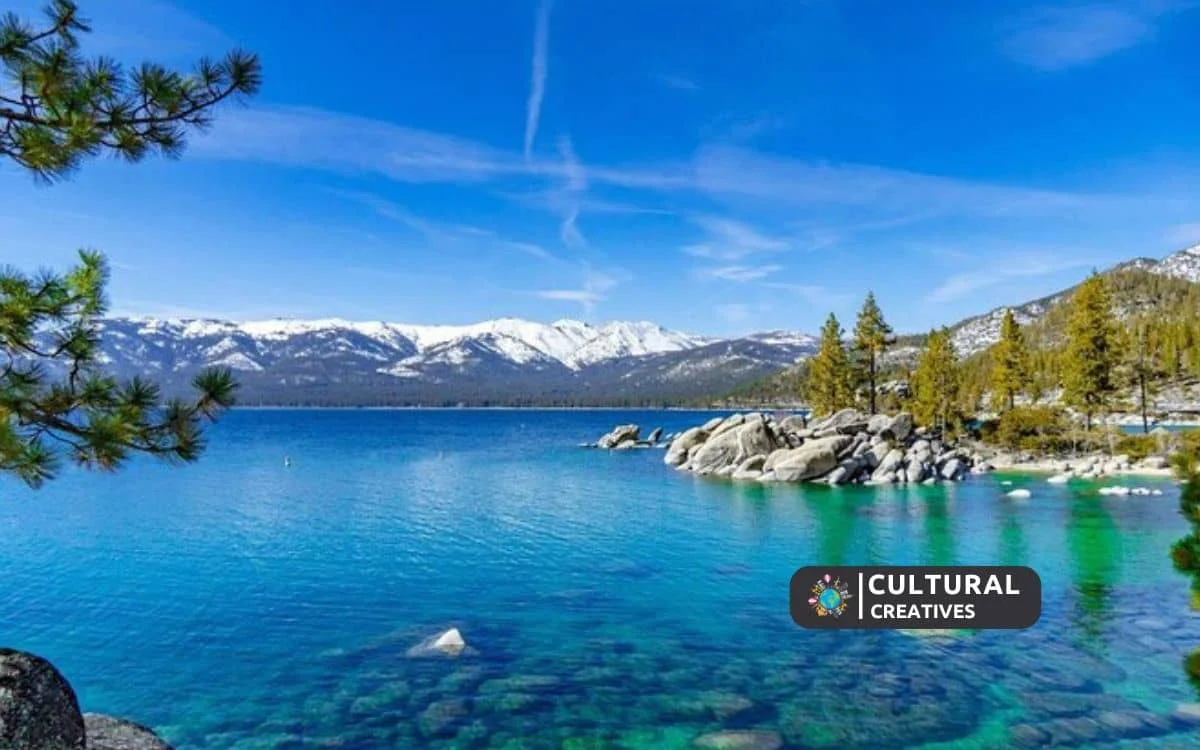Lake Tahoe sits at an elevation of 6,225 feet (1,897 meters) above sea level. This alpine lake, nestled in the Sierra Nevada mountains, is renowned for its crystal-clear waters and scenic vistas.
Lake Tahoe is one of the largest freshwater lakes in the United States by volume, and with a depth of 1,645 feet (501 meters), it is also one of the deepest. The lake straddles the state line between California and Nevada, offering a diverse array of activities year-round.
Visitors flock to its shores for skiing and snowboarding in the winter, while the warmer months bring opportunities for hiking, boating, and enjoying the stunning natural beauty. The combination of high altitude and outdoor adventure makes Lake Tahoe a prime destination for nature enthusiasts and adventure seekers alike.
Lake Tahoe’s Majestic Location
Lake Tahoe’s Majestic Location commands attention with its stunning geography and impressive altitude. Nestled in the Sierra Nevada mountains, this natural wonder sits high above the mundane, promising an elevation that’s as breathtaking as its crystalline waters.
Geographic Setting Of Lake Tahoe
The geographic splendor of Lake Tahoe is undeniable. Surrounded by snow-capped peaks and lush forestland, its location is both unique and awe-inspiring.
- Elevation: Approximately 6,225 feet (1,897 meters) above sea level.
- Cradled by mountains, with some peaks reaching over 10,000 feet.
- Straddling two states: California and Nevada.
Comparing Tahoe To Other High-altitude Lakes
When considering high-altitude lakes, Tahoe ranks remarkably. Let’s compare its towering elevation with others around the world.
| Lake | Altitude (feet) | Location |
|---|---|---|
| Lake Titicaca | 12,507 | Bolivia/Peru |
| Lake Tahoe | 6,225 | USA |
| Lake Wanaka | 915 | New Zealand |
Although Lake Titicaca claims the title for the highest navigable lake, Lake Tahoe proudly stands as one of the highest in the USA. Its elevation surpasses that of Lake Wanaka in New Zealand, offering a unique ecosystem and stunning clarity.
The Numbers Behind The Altitude
The allure of Lake Tahoe extends beyond its crystal-clear waters and majestic mountain surroundings. Its impressive elevation is a topic of interest for many visitors and locals alike. Understanding the numbers behind the altitude provides a glimpse into the unique high-altitude environment of this natural wonder.
Exact Elevation Of Lake Tahoe
Lake Tahoe boasts a remarkable elevation. Nestled in the Sierra Nevada mountains, it sits 6,225 feet (1,897 meters) above sea level. This makes it one of the highest large lakes in the United States. The altitude provides stunning panoramas and affects both climate and ecology.
How Elevation Is Measured
Elevation refers to the height of a location above sea level. Sea level is the average height of the ocean’s surface, known as the geoid. To measure elevation, scientists use various tools:
- Barometric Altimeters: These devices gauge altitude by measuring air pressure. As elevation rises, air pressure drops.
- GPS Devices: Using satellites, GPS measures elevation with precision by triangulating a position relative to sea level.
- Topographic Maps: Created from survey data, these maps show elevation via contour lines. They help hikers and geographers understand terrain.
Factors like the Earth’s gravitational pull and changes in sea level can influence elevation measurements. These tools ensure the numbers are as accurate as possible.
Implications Of Tahoe’s High Altitude
The majestic Lake Tahoe, nestled in the Sierra Nevada mountains, stands remarkably at an altitude of 6,225 feet above sea level. This elevated status has a ripple effect on the locale, influencing everything from the climate to the ecosystem. Let’s delve into the unique implications that come with Tahoe’s soaring altitude.
Effects On Climate And Weather
Lake Tahoe’s lofty perch dramatically shapes its atmospheric conditions. Visitors to the area should expect:
- Thinner air, resulting in less oxygen.
- Cooler temperatures, due to high elevation.
- Increased ultraviolet radiation, requiring sun protection.
- Snowfall persisting into spring, ideal for winter sports enthusiasts.
These factors combined create a unique weather pattern that outdoor adventurers need to prepare for when visiting.
Impact On Wildlife And Vegetation
The diverse habitats of Lake Tahoe give rise to a rich tapestry of life. At high altitudes, the flora and fauna endure various conditions:
| Wildlife | Vegetation |
|---|---|
|
|
These characteristics ensure that Lake Tahoe’s ecosystem is not only beautiful but also resistant to the harsh conditions at higher elevations.
Adventures At Altitude
Lake Tahoe, nestled between California and Nevada, stands as a sparkling jewel in the Sierra Nevada. Perched at an impressive 6,225 feet (1,897 meters) above sea level, it is a pristine sanctuary for adventure seekers. The elevation adds an exhilarating twist to the vast array of activities available.
Outdoor Sports And Recreational Activities
Thrills await at every corner of this alpine paradise. Experience the rush of the following:
- Skiing and Snowboarding: Shredding down world-class slopes with breathtaking views.
- Hiking: Trail your way through scenic paths and witness the full splendor of the Sierra Nevada.
- Mountain Biking: Pedal along rugged terrains and adrenaline-inducing trails.
- Boating and Kayaking: Paddle across the crystal-clear waters for a serene or spirited day out.
- Fishing: Cast a line into the depths for a chance to snag a trophy fish.
Challenges And Precautions For Visitors
Though the elevation boosts the excitement, it also introduces unique challenges.
| Challenge | Precaution |
|---|---|
| Altitude Sickness | Acclimate gradually, stay hydrated, and consider medications if needed. |
| UV Exposure | Apply broad-spectrum sunscreen, wear hats and UV-blocking sunglasses. |
| Cold Weather | Dress in layers, keep exposed skin covered, and take frequent breaks indoors. |
| Rapid Weather Changes | Check forecasts, carry emergency supplies, and dress appropriately for potential weather shifts. |
Preserving Tahoe’s Elevated Environment
The jewel of the Sierra Nevada, Lake Tahoe sits pristinely at 6,225 feet (1,897 meters) above sea level. This alpine treasure, with its clear blue waters, is more than just a scenic escape. It is an environment needing protection. Preserving Tahoe’s elevated environment ensures that this natural wonder endures for generations to come.
Conservation Efforts And Ecological Importance
To safeguard Lake Tahoe’s unique ecosystem, diverse conservation efforts are in place. The lake’s clarity is iconic, signaling the health of the region. Reduced clarity indicates ecosystem stress. Restoration projects aim to preserve its famous clear waters. These initiatives include:
- Forest management
- Wetland restoration
- Invasive species control
Conserving habitats also means protecting species like the Lahontan cutthroat trout. This fish is unique to Lake Tahoe. Conservation helps keep the balance in this delicate Alpine ecosystem.
Sustainable Tourism And Community Involvement
Lake Tahoe attracts millions of visitors annually. Sustainable tourism practices help maintain its beauty. Visitors play a crucial role. They adhere to ‘Leave No Trace’ principles. These principles guide responsible tourism. The community also gets involved with:
- Educational programs
- Beach clean-ups
- Sustainable business practices
Local involvement is essential. It ensures that both the economy and the environment thrive. Everyone benefits when nature and communities support each other.
Conclusion
Lake Tahoe’s elevation stands as a majestic natural wonder, towering 6,225 feet above sea level. This alpine lake, with its crystal-clear waters and breathtaking vistas, truly is a jewel nestled in the Sierra Nevada Mountains. Whether you’re seeking adventure or serenity, Lake Tahoe’s altitude is a key contributor to its unique beauty and the myriad of activities it offers year-round.
Remember, the elevation is not just a number—it’s a part of what makes Tahoe unforgettable.






